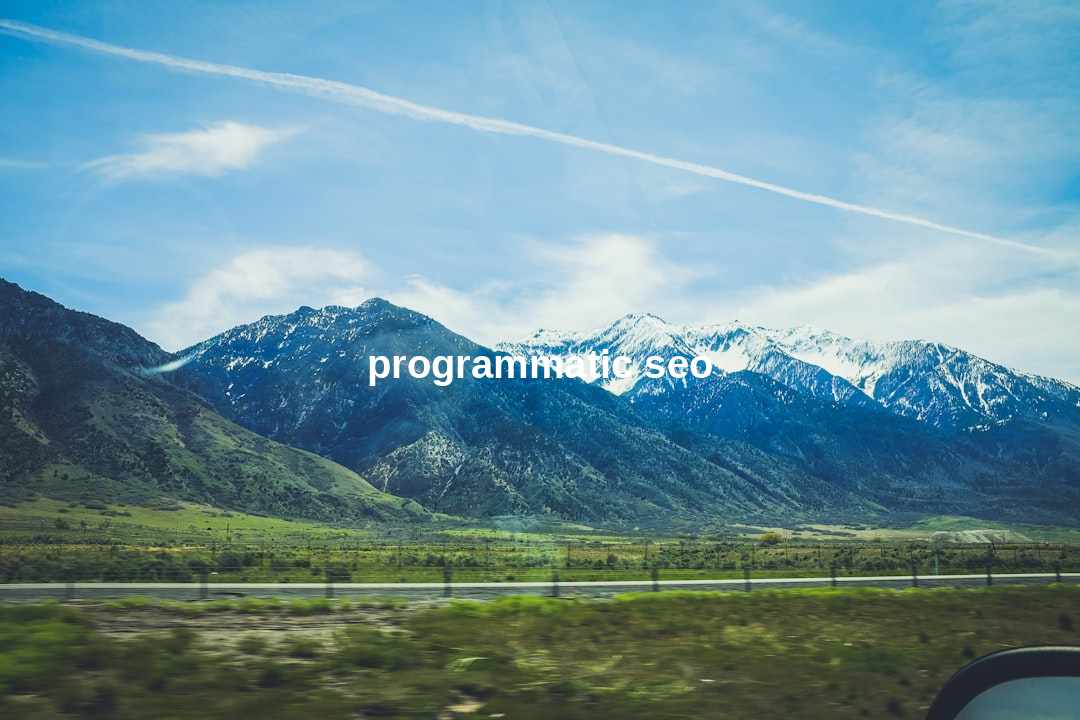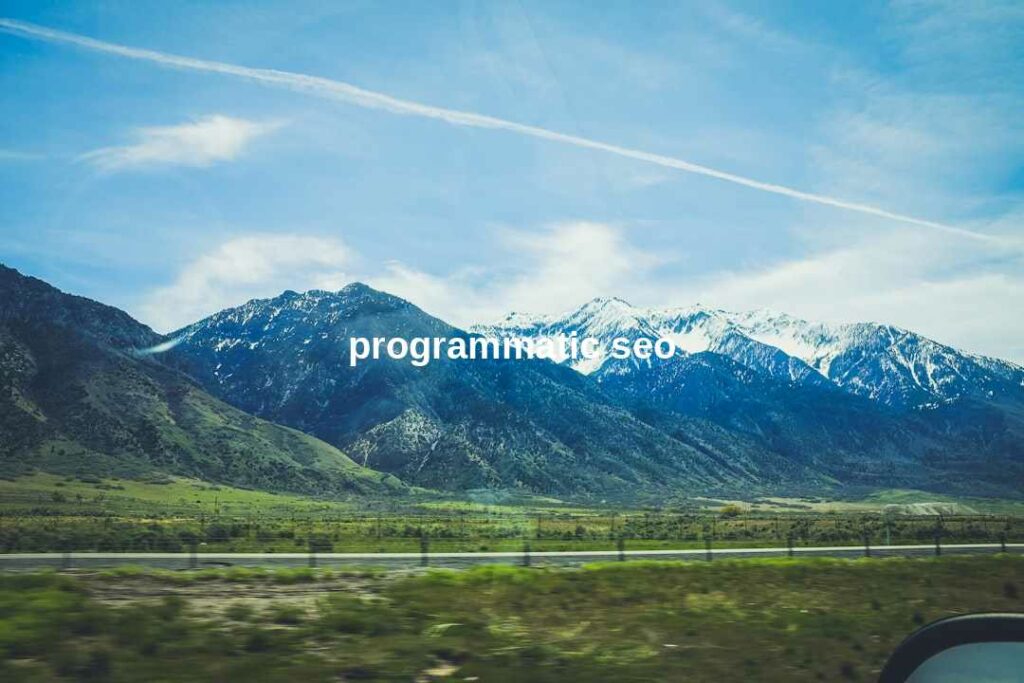In the ever-evolving world of search engine optimization (SEO), a new approach has emerged, revolutionizing the way businesses reach their vast online audiences. This technique, known as programmatic SEO, combines the power of SEO with the precision of automation and data analysis. By leveraging technology to create and optimize a large number of web pages, programmatic SEO empowers websites to capture long-tail search traffic that may have been overlooked in a traditional SEO approach. As we dive into the intricacies and benefits of this advanced strategy, we’ll discover just how essential it has become for companies aiming to establish a commanding online presence.
| Aspect | Details | Benefits | Challenges |
|---|---|---|---|
| Definition | The use of software to automate SEO for large-scale websites | Efficiency, scalability, and ability to capture long-tail traffic | Requires advanced tools and expertise in both SEO and programming |
| Key Components | Keyword research, content generation, on-page optimization | Comprehensive and targeted content coverage | Maintaining content quality and relevance at scale |
| Best Practices | Structured data, quality content, user experience focus | Improved search rankings and user engagement | Balancing automation with human oversight |
| Tools Used | SEO platforms, CMS, data analysis software | Streamlined workflow and data-driven decisions | Integration and learning curve for new platforms |
Understanding Programmatic SEO: The Evolution of Large-Scale Search Optimization
Commencing our deeper voyage into programmatic SEO, it is imperative to acknowledge the transformation brought upon by this modern methodology. As traditional SEO techniques have saturated the digital landscape, leading to high levels of competition for a limited number of high-traffic keywords, businesses and SEO professionals sought an innovation that could change the game.
The Shift from Manual to Automated SEO
Programmatic SEO is not merely about escalation in quantity; it’s the intelligent expansion of SEO’s qualitative touch. What once was an entirely manual and often tedious process—keyword research, content creation, and on-page optimization—is now being streamlined through automation, albeit with strategic human guidance. The proficiency of algorithms and machine learning to dissect gigantic amounts of data has ushered in a renaissance of search optimization, where decision-making is rapid yet informed.
Artificial intelligence now scours the internet to identify search patterns and emerging trends, empowering the development of an SEO strategy that’s not only reactive but proactive in nature. Content strategies are then based not on gut feelings but on data-driven insights that can pinpoint countless long-tail keywords, each representing a unique opportunity to capture niche market segments.
Moreover, programmatic SEO embodies scalability previously unattainable. Imagine generating thousands of landing pages, each carefully crafted to target specific keyword clusters, demographic groups, or geographic locales. This sort of targeted content creation ensures that businesses can maintain relevance across diversified markets, accommodating for user search intent in granular detail.
It is crucial, however, to complement the technological side of programmatic SEO with human expertise. Quality control, brand voice consistency, and editorial judgment remain indispensable. The magic happens when the accuracy of machines collides with the creative and strategic prowess of human SEO experts—an alliance that defines the new era of large-scale search optimization.
How Top Companies Leverage Automated Content to Dominate SERPs

Programmatic SEO allows companies to produce content at scale, targeting a multitude of long-tail keywords, which can dominate search engine results pages (SERPs) and capture niche markets with high precision.
The Strategic Edge in SERP Domination
Leading companies are utilizing programmatic SEO to great effect by automatically generating content that caters to a wide array of search queries. Through sophisticated software, they analyze search data to pinpoint opportunities for long-tail keywords—phrases that are more specific and less competitive than broader terms. By addressing these specific, often-overlooked queries in their content, businesses can effectively saturate the SERPs with their domain, offering precise solutions to a variety of user needs. This strategy not only increases their digital footprint but also taps into markets that competitors may have missed.
Case Studies of Success
Evidence of this can be seen in how e-commerce giants and online service providers have refined their approach. For example, an online retailer might use programmatic SEO to generate individual product descriptions for an expansive inventory, thereby creating a separate, optimized page for each item. This level of specificity in content creation grants them visibility across countless product searches. Additionally, service-oriented platforms use programmatic SEO to regionalize their offerings, ensuring that potential customers find local services rendered by the company in their SERP.
Building a Programmatic SEO Foundation: Research and Strategy Development
Effective programmatic SEO begins with meticulous keyword research and strategic planning, forming a data-driven foundation that underpins all subsequent automated content generation.
Commencing with Comprehensive Research
Success in programmatic SEO is contingent on the groundwork laid before any content creation takes place. This involves an extensive analysis of search terms, user intent, and competitive landscapes. Companies must invest in robust keyword research tools that can uncover a vast array of suitable keywords. By doing so, they ensure that every piece of content produced is not only relevant but also has the potential for high search visibility.
Strategizing for Scalability and Relevance
Once the research phase is complete, companies must develop a programmatic SEO strategy that aligns with their business goals and is capable of scaling. This strategy should dictate how content is to be generated and optimized, considering factors such as search volume, keyword difficulty, and relevance to the user’s search intent. It’s crucial for businesses to set in place editorial guidelines and SEO best practices to uphold the quality of content as it is produced programmatically.
Best Practices for Creating High-Quality Landing Pages at Scale
Adhering to SEO best practices while producing landing pages programmatically is vital for ensuring that the content remains engaging, relevant, and capable of ranking well in SERPs.
Maintaining Content Quality at Scale
The true challenge of programmatic SEO is to maintain content quality while producing pages on a massive scale. It requires a delicate balance between automation and human involvement. It is essential to ensure each page provides genuine value to the user, with well-researched information, a clear structure, and an engaging format. Even though the process is automated, a level of manual oversight is essential for quality assurance.
Technical Optimization for Peak Performance
Alongside high-quality content, technical SEO elements must also be meticulously optimized. This includes using clean, responsive design, optimizing page loading speeds, and ensuring that all pages are mobile-friendly. Additionally, metadata, including titles and descriptions, should be automatically generated to accurately describe page content and encourage click-through rates from SERPs.
Tailoring content to cater to user intent and deploying strategic internal linking are additional layers that enhance the effectiveness of landing pages produced through programmatic SEO. By doing so, companies not only provide value to their users but also create a cohesive and powerful website structure that search engines reward with higher rankings.
Conclusion: The Future of SEO in an Automated World
As we have explored the multifaceted realm of programmatic SEO, it is clear that the synergy between automation and human expertise is reshaping the landscape of search engine optimization. The ability to generate vast amounts of targeted, quality content has allowed businesses to efficiently scale their online presence and dominate niche markets. The precision with which programmatic SEO operates makes it an indispensable asset for companies looking to thrive in the competitive digital ecosystem. The transformative potential of programmatic SEO is undeniable, as it continues to refine and revolutionize the strategies employed by SEO professionals and marketers alike. Moving forward, the integration of emerging technologies such as AI and machine learning will only expand the capabilities and influence of programmatic SEO, signaling an era where data-driven decision-making reigns supreme in the quest for search engine supremacy.
- Programmatic SEO automates the content creation process, allowing for the production of web pages at an unprecedented scale.
- Keyword research and strategic planning are the cornerstones of a successful programmatic SEO strategy.
- High-quality, relevant content and technical optimization are crucial for the success of programmatic landing pages.
- Top companies leverage programmatic SEO to efficiently capture long-tail traffic and dominate SERPs.
- The evolution of SEO practices has made programmatic SEO indispensable for managing large-scale SEO campaigns.
- Despite automation, human oversight remains essential to ensure content quality and adherence to SEO best practices.
- The future of programmatic SEO promises increased reliance on AI and analytics for data-driven optimization strategies.

